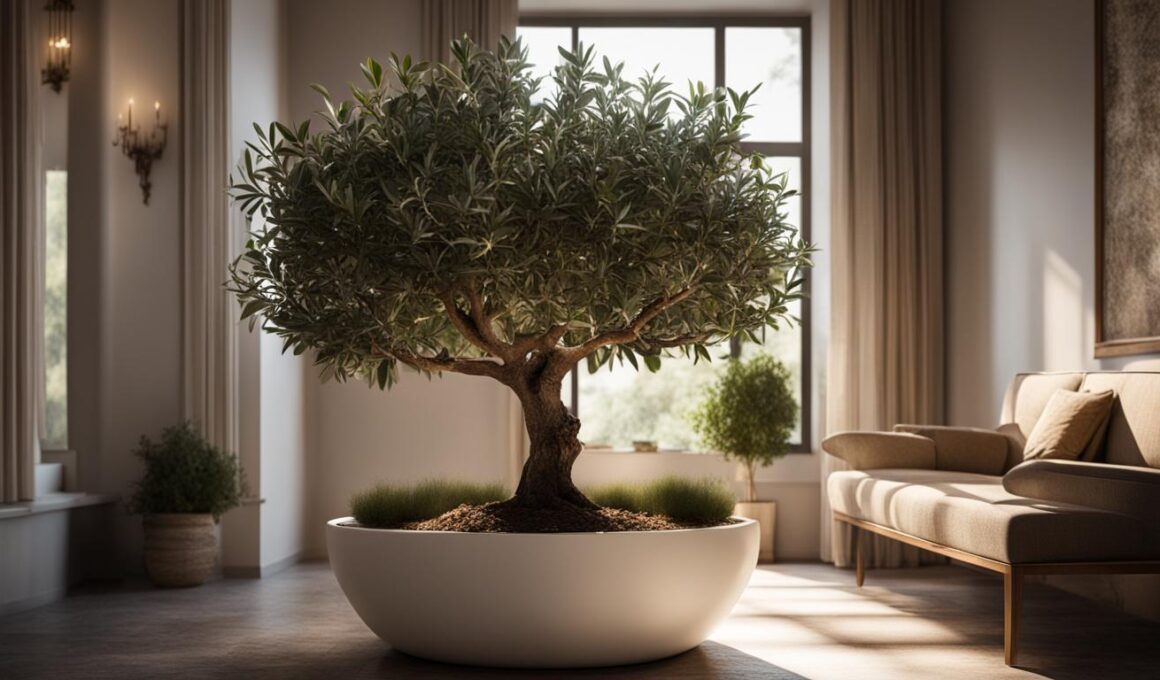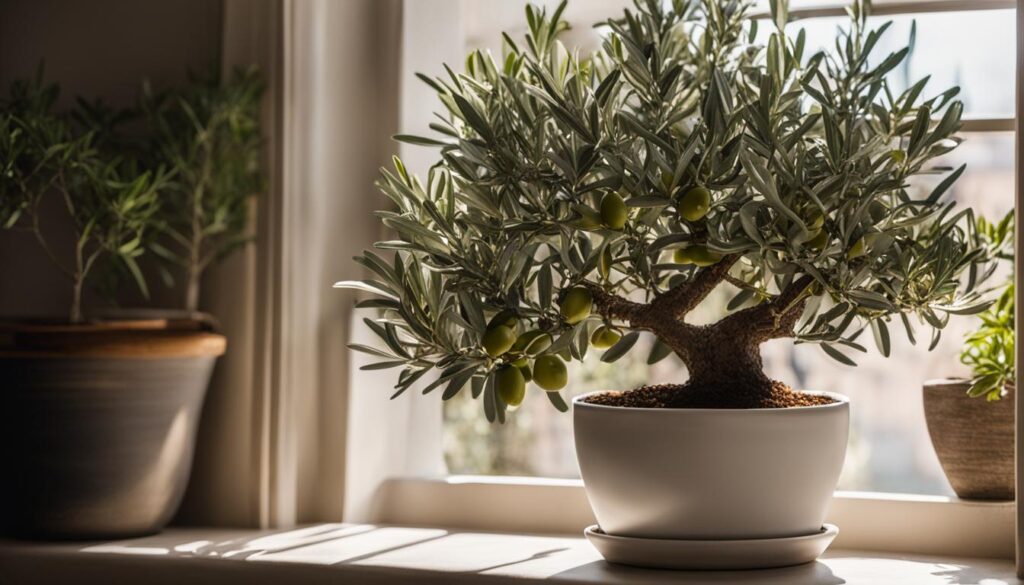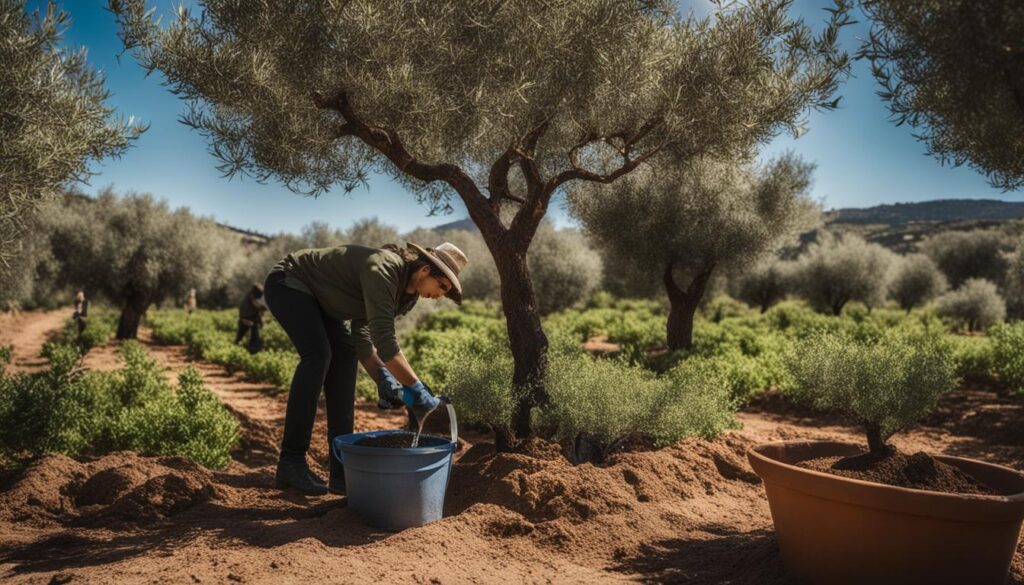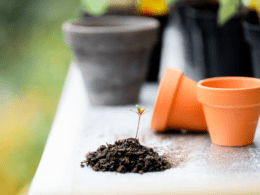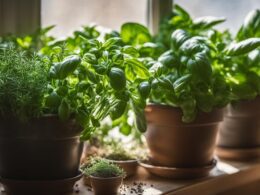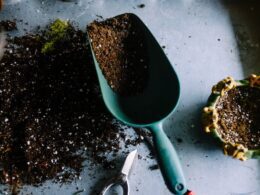The Arbequina Olive Tree, also known as Olea europaea ‘Arbequina’, is a popular and low-maintenance evergreen tree that produces delicious olives. It can be easily grown indoors, making it suitable for any climate. All you need is a sunny window and well-draining soil. The Arbequina Olive Tree is self-fertile, but hand pollination can increase fruit production. With proper care, you can enjoy the satisfaction of growing your own fresh and organic olives right in your home.
Post Summary
- Growing an Arbequina Olive Tree indoors allows you to enjoy fresh and organic olives in any climate.
- A sunny window and well-draining soil are essential for successful indoor cultivation.
- Hand pollination can help increase fruit production.
- Proper care and maintenance are crucial for the health and productivity of your olive tree.
- Harvested olives can be used to make delicious homemade olive oil.
Growing Arbequina Olive Trees Indoors
The Arbequina Olive Tree is well-suited for indoor growth. It thrives with 4 to 8 hours of sunlight per day, making it ideal for a sunny window. When choosing a container, opt for one that is 1.5 to 2 times wider than the plant’s shipped container. Olive trees prefer well-draining, rocky soil, so a mix of potting soil and perlite or small rocks is recommended. Clay or wooden containers are best for optimal results. Hand pollination can help increase fruit production, especially when grown indoors.
Optimizing Sunlight
Positioning your Arbequina Olive Tree near a sunny window is crucial for its growth and fruit production. Ensure that the tree receives enough sunlight exposure by placing it in a window that receives direct sunlight for the majority of the day. If necessary, consider using a grow light to supplement sunlight during the darker months or if natural light is limited. Adequate sunlight is essential for the tree to thrive and produce a bountiful harvest of olives.
Choosing the Right Container and Soil
When selecting a container for your Arbequina Olive Tree, it’s important to choose one that allows for proper drainage. This will prevent waterlogged soil, which can lead to root rot and other issues. Opt for a container with drainage holes at the bottom. Additionally, using well-draining soil is crucial for the tree’s overall health. A mix of potting soil and perlite or small rocks will help ensure proper drainage and promote healthy root growth.
Hand Pollination for Increased Fruit Production
While the Arbequina Olive Tree is self-fertile, hand pollination can significantly increase fruit production, particularly when grown indoors. To hand pollinate your olive tree, gently transfer pollen from one flower to another using a small brush or cotton swab. This mimics the natural pollination process and helps ensure successful fruit set. Regular hand pollination throughout the flowering season can result in a larger yield of delicious olives.
Remember, growing Arbequina Olive Trees indoors can be a rewarding experience that allows you to enjoy the beauty of this evergreen tree and the satisfaction of harvesting your own fresh olives. By providing adequate sunlight, choosing the right container and soil, and practicing hand pollination, you can successfully grow and care for your Arbequina Olive Tree, ensuring a fruitful harvest of olives.
Care for Arbequina Olive Trees Outdoors
The Arbequina Olive Tree is not only suitable for indoor growth but can also thrive outdoors in Zones 8 to 11. To ensure the health and productivity of your outdoor Arbequina Olive Tree, proper care is essential. Here are some key factors to consider:
Well-Drained Soil:
Arbequina Olive Trees require well-drained soil to prevent root rot and promote healthy growth. Plant the tree in soil that has good drainage to ensure excess water does not accumulate around the roots. Avoid heavy clay soil, as it tends to retain moisture, and instead opt for sandy or loamy soil.
Sunlight:
Arbequina Olive Trees need 4 to 8 hours of sunlight per day to thrive outdoors. Choose a sunny location in your garden or yard that receives adequate sunlight throughout the day. Ensure that no large trees or structures cast shade on the tree, as this can hinder its growth and fruit production.
Planting and Watering:
When planting your Arbequina Olive Tree outdoors, dig a hole that is twice the width of the tree’s root ball. This will provide enough space for the roots to spread out and establish themselves. After planting, water the tree thoroughly to help settle the soil and remove any air pockets. Water the tree regularly, especially during hot and dry periods, to keep the soil moist but not waterlogged.
| Aspect | Details |
|---|---|
| Soil Type | Well-drained, sandy or loamy soil |
| Sunlight | 4 to 8 hours of direct sunlight per day |
| Planting | Dig a hole twice the width of the root ball, water thoroughly after planting |
| Watering | Maintain moist but not waterlogged soil, especially during dry periods |
Proper care and attention to the soil and sunlight requirements of your Arbequina Olive Tree will ensure its successful growth and fruit production outdoors. Remember to choose well-drained soil, provide ample sunlight, and follow proper planting and watering techniques. With the right care, you can enjoy a bountiful harvest of fresh and organic olives straight from your own garden.
By following these care tips, you can foster the healthy development of your Arbequina Olive Tree and enjoy an abundant harvest of delicious olives. With proper attention to well-drained soil, sufficient sunlight, and regular watering, your Arbequina Olive Tree will thrive in an outdoor setting. By providing the optimal conditions and care, you can enjoy the beauty of this evergreen tree and the satisfaction of growing your own fresh and organic olives.
Long-term Care for Arbequina Olive Trees
Proper long-term care is crucial for the health and productivity of your Arbequina Olive Trees. Paying attention to soil moisture, establishing a watering schedule, and fertilizing appropriately are key factors in ensuring the success of your olive trees.
Soil Moisture
Keeping the soil adequately moist is vital for the overall well-being of your Arbequina Olive Trees. Regularly check the moisture level by inserting your finger 1 to 2 inches deep into the soil. If the soil feels dry at this depth, it’s time to water. Avoid over-watering as it can lead to root rot and other health issues. Aim to water the trees one to two times per week, ensuring that the soil remains evenly moist but not saturated.
Watering Schedule
Establishing a consistent watering schedule is essential for the long-term care of your olive trees. Providing them with a steady supply of water helps them thrive and produce an abundant harvest. Create a schedule that aligns with your climate and the specific needs of your trees. Be mindful of any changes in weather conditions, as they might affect the frequency of watering required. Additionally, consider using a drip irrigation system to provide a slow and consistent water supply directly to the root zone of the trees.
Fertilizing
Fertilizing your Arbequina Olive Trees is crucial for promoting healthy growth and enhancing fruit production. Choose a high-nitrogen blend, such as a 17-6-10 fertilizer, in a time-release formula. Apply the fertilizer twice a year: once in the spring and once in the fall. Follow the manufacturer’s instructions for the appropriate dosage and application method. Fertilize the trees around the drip line, avoiding direct contact with the trunk. Regular fertilization will provide the trees with the necessary nutrients to develop strong branches and bountiful fruit.
| Care Aspect | Guidelines |
|---|---|
| Soil Moisture | Keep soil evenly moist, checking moisture level regularly. |
| Watering Schedule | Water one to two times per week, adjusting for climate and weather conditions. |
| Fertilizing | Apply high-nitrogen fertilizer twice a year in a time-release formula. |
Frequently Asked Questions About Arbequina Olive Trees
- Should I hand pollinate my indoor Arbequina Olive Tree? While hand pollination can enhance fruit production, it is not necessary for indoor trees. The Arbequina Olive Tree is self-fertile and can produce fruit without additional intervention.
- How often should I water my Arbequina Olive Tree? It is essential to maintain proper soil moisture for your olive tree. Water it thoroughly once or twice a week, ensuring the soil is moist but not waterlogged. Check the moisture by inserting your finger into the soil to a depth of 1 to 2 inches.
- How long does it take for Arbequina Olives to ripen? Arbequina Olives typically start as light green and progress to a brownish-purple shade when ripe. The ripening process can take several months, depending on the climate and growing conditions. Harvest the olives when they reach their desired level of color and flavor.
By implementing these planting tips and providing proper care, your Arbequina Olive Tree will thrive and reward you with a bountiful harvest of fresh and delicious olives.
Harvesting and Using Arbequina Olives
Growing your own Arbequina Olive Tree not only provides you with a beautiful and low-maintenance plant, but it also offers the opportunity to harvest your own olives. The process of harvesting and using Arbequina olives involves a few key steps that ensure the best flavor and quality of the fruit.
The first step in harvesting Arbequina olives is to wait for them to ripen. The olives go through a color transformation, starting from light green and gradually turning to soft pink and finally to a brownish-purple shade. This is an indication that they are ready to be picked. It’s important to wait until the olives are fully ripe to achieve the best flavor.
Once harvested, the olives need to go through a curing process to remove bitterness and enhance their taste. There are two common methods of curing olives: brine curing and water curing. Brine curing involves soaking the olives in a saltwater solution, which helps draw out the bitterness. Water curing, on the other hand, involves placing the olives in water and changing the water daily for several weeks. Both methods result in delicious olives that can be enjoyed as a snack or used in various culinary applications.
One of the greatest benefits of growing Arbequina Olive Trees is the high oil concentration in the olives. This makes them perfect for making your own olive oil. The oil can be extracted using a mechanical press or by hand. Homemade olive oil adds a unique and flavorful touch to dressings, marinades, and dipping oils, elevating your culinary creations to the next level.
Harvesting and Using Arbequina Olives – Key Points:
- Wait until the olives are fully ripe, indicated by a brownish-purple color.
- Cure the olives using the brine or water method to remove bitterness.
- Explore the versatility of homemade olive oil in dressings, marinades, and dipping oils.
Characteristics of Arbequina Olive Trees
The Arbequina Olive Tree is known for its unique characteristics that make it a desirable addition to any garden or indoor space. Here are some of the key features that define this variety:
- Appearance: The Arbequina Olive Tree is an aesthetically pleasing plant with gracefully dropping branches adorned with shiny, silvery-green leaves. It adds a touch of elegance to any landscape or indoor setting.
- Height: When planted in the ground, mature Arbequina Olive Trees can reach heights of up to 15 feet. However, they can also be pruned to maintain a smaller size, making them versatile for various spaces.
- Fruit: The olives produced by Arbequina Olive Trees undergo a beautiful transformation throughout their ripening process. They start off green and gradually transition to pale pink, deep purple, and finally near-black when fully ripe.
The Arbequina Olive Tree is self-pollinating and typically begins producing fruit within a few years of planting. The olives have a light, fruity flavor that can be enjoyed at different stages of ripeness. Whether you’re looking to use them for eating or pressing into your own homemade olive oil, the Arbequina variety offers a delicious fruit that adds a unique touch to various culinary applications.
Conclusion
Growing an Arbequina Olive Tree indoors is a rewarding experience that allows you to indulge in the beauty of this evergreen tree and the satisfaction of growing your own fresh and organic olives. With the right care, you can have a thriving olive tree right in your home, regardless of your climate.
Indoor gardening with the Arbequina Olive Tree offers a unique opportunity to connect with nature and enjoy the taste of homegrown olives. Whether you use the olives for eating or pressing into oil, the Arbequina variety provides a delightful fruit that can be savored in a variety of culinary applications.
By adding an Arbequina Olive Tree to your home, you can truly embrace the joy of indoor gardening and relish in the bounty of nature’s gifts. Start your journey today and experience the satisfaction of nurturing an olive tree and reaping the rewards of your efforts.
FAQ
Can I grow an Arbequina Olive Tree indoors?
Yes, the Arbequina Olive Tree can be easily grown indoors as long as you provide it with a sunny window and well-draining soil.
Does the Arbequina Olive Tree need hand pollination?
While the Arbequina Olive Tree is self-fertile, hand pollination can help increase fruit production, especially when grown indoors.
How much sunlight does the Arbequina Olive Tree need?
The Arbequina Olive Tree thrives with 4 to 8 hours of sunlight per day, making it ideal for a sunny window.
Can the Arbequina Olive Tree be grown outdoors?
Yes, the Arbequina Olive Tree can be grown outdoors in Zones 8 to 11. The care instructions for outdoor growth are similar to indoor care.
How often should I water an Arbequina Olive Tree?
It is recommended to establish a regular watering schedule of one to two waterings per week, depending on the moisture level of the soil.
How do I harvest and cure Arbequina olives?
The olives should be harvested when they transition from light green to brownish-purple. They then need to go through a curing process to remove bitterness. They can be brine cured or water cured.
What are the characteristics of Arbequina Olive Trees?
Arbequina Olive Trees have gracefully dropping branches adorned with shiny, silvery-green leaves and small, fragrant white blossoms in the spring. The olives start off green and turn to pale pink, deep purple, and finally near-black when ripe.
Can I make my own olive oil from Arbequina olives?
Yes, the Arbequina Olive Tree produces olives with a high oil concentration, making them perfect for making your own olive oil. The oil can be used in various culinary applications.
Can Arbequina Olive Trees Be Grown Indoors Without Causing Invasive Roots?
Yes, fruitless olive tree roots are not invasive, making them a great option for indoor cultivation. Arbequina olive trees, with their non-invasive roots, can be grown in containers indoors, providing an attractive and low-maintenance option for olive tree enthusiasts without worrying about invasive root systems.





